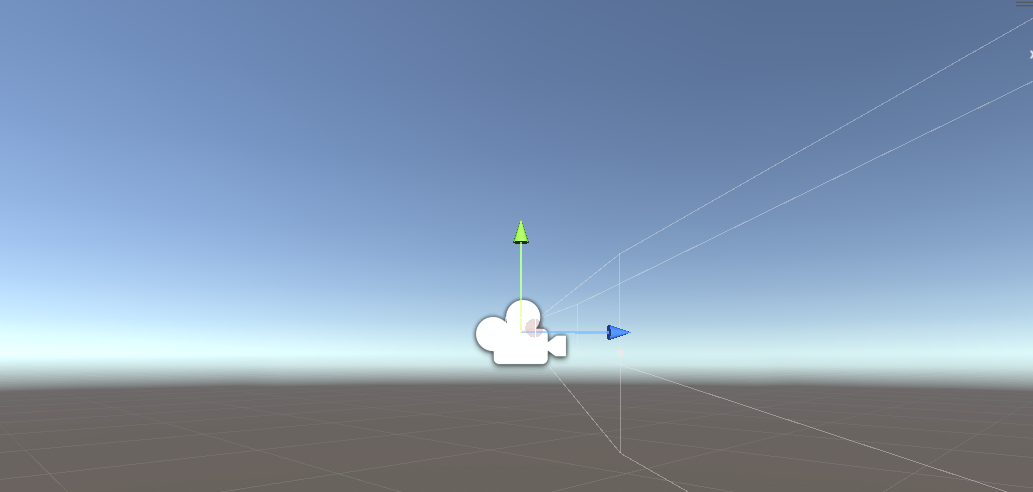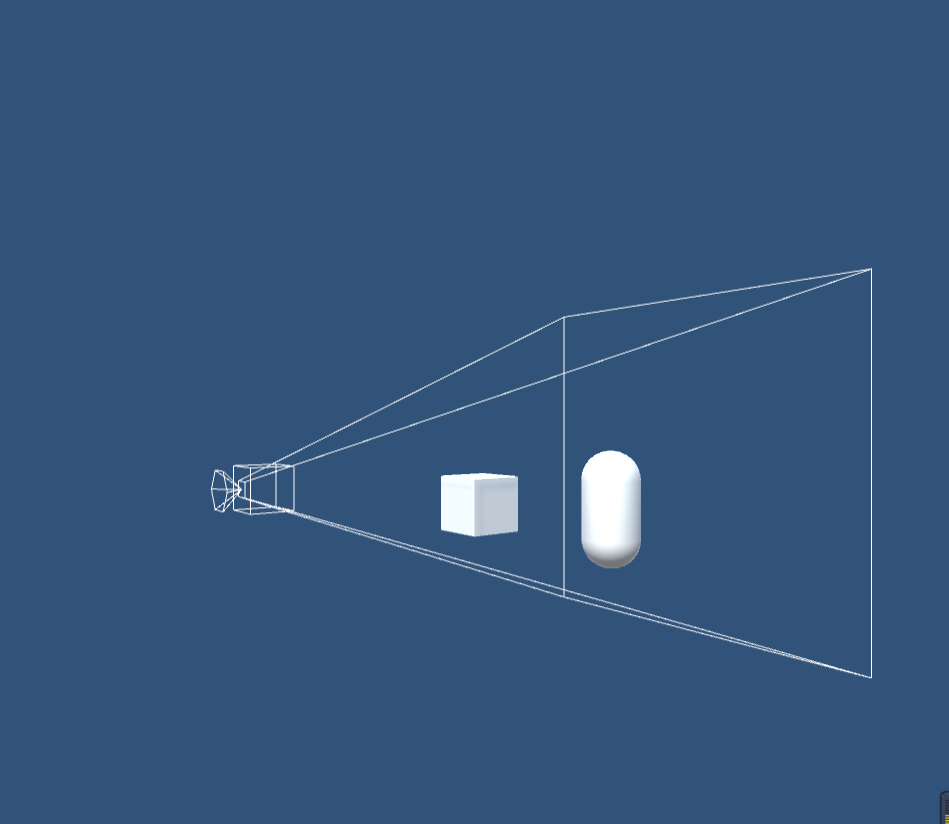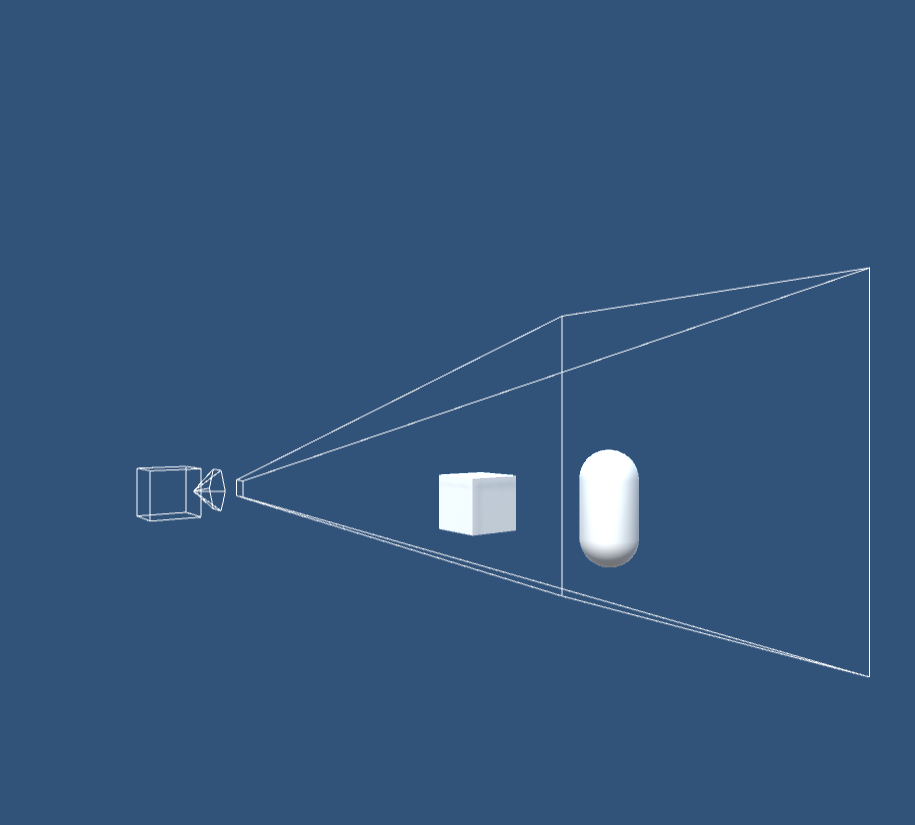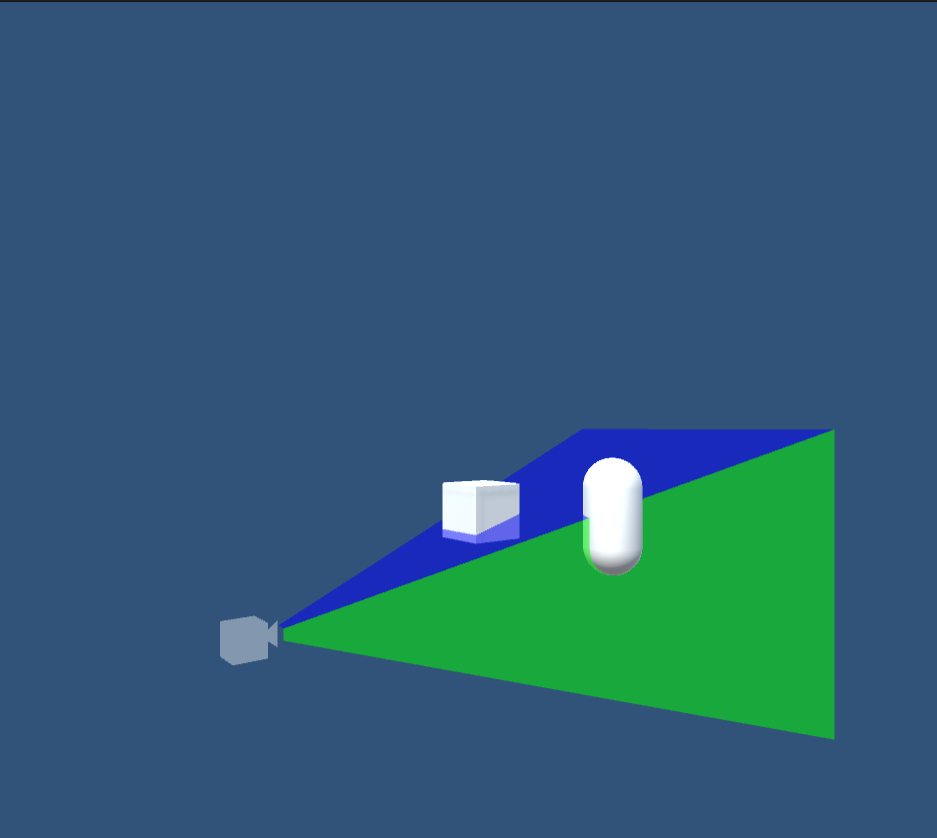这是某天一朋友让帮忙看的一个功能,大概就是想要一个在运行时可以可视化看到模型是否在特定Camera的 Frustum内的逻辑,功能不难,但是有些点需要注意下,整理出来做个简单记录。
听到这个逻辑需求,很容易能想到,不就是类似引擎编辑器相机的可视化需求么?

不过这位朋友不想用特定图标来表示相机,而是希望直接用顶点数据来绘制相机,另外模型是否在Frustum内需要能够清晰的可以让用户看到,所以决定分成两步,先实现类似引擎编辑器相机的可视化功能。

基于上述功能,进行迭代。

这样模型出入Frustum就可以看到了 。

开始功能之前需要了解MVP矩阵的作用是将模型从其本地坐标系变换到裁剪坐标系(Clip Space)中的立方体(范围为[-w, w]³)的过程,其中w值可以理解为是在MV矩阵变换顶点后的z值坐标,顶点到相机的距离越远,w的值就越大。接着通过透视除法操作,即将裁剪空间中的坐标除以w,以得到NDC坐标,这个立方体就称为规范化设备坐标(Normalized Device Coordinates,NDC),在NDC坐标系中,其范围是从-1到1的立方体。
基于上述的理论,我们可以定义一个以[-1, 1]³的立方体为边界的顶点数据,通过乘于VP矩阵的逆矩阵把该顶点数据变换为世界坐标即可绘制Frustum。
我们定义两个部分的顶点数据,一个用来表示相机图标的Gizmo,一个用来描述Frustum:
void createCameraGizmo()
{
// 定义顶点数据
gizmoVertices = new List<Vector3> {
new Vector3(-1, -1, 1), //0
new Vector3( 1, -1, 1),//1
new Vector3(-1, 1, 1), //2
new Vector3( 1, 1, 1),//3
new Vector3(-1, -1, 3),//4
new Vector3( 1, -1, 3),//5
new Vector3(-1, 1, 3),//6
new Vector3( 1, 1, 3),//7
new Vector3( 0, 0, 1),//8(视锥顶点)
};
// 定义索引数据
gizmoIndices = new List<int> {
0, 1, 1,
3, 3, 2,
2, 0, 4,
5, 5, 7,
7, 6, 6,
4, 0, 4,
1, 5, 3,
7, 2, 6,
};
// 描述相机Gizmo的朝向
int numSegments = 6;
int coneBaseIndex = gizmoVertices.Count * 3 / 3;
int coneTipIndex = coneBaseIndex - 1;
for (int i = 0; i < numSegments; ++i)
{
float u = (float)i / (float)numSegments;
float angle = u * Mathf.PI * 2.0f;
float x = Mathf.Cos(angle);
float y = Mathf.Sin(angle);
gizmoVertices.Add(new Vector3(x, y, 0));
// 从顶点到锥体边缘的连线
gizmoIndices.Add(coneTipIndex);
gizmoIndices.Add(coneBaseIndex + i);
// 锥体底边的连线
gizmoIndices.Add(coneBaseIndex + i);
gizmoIndices.Add(coneBaseIndex + (i + 1) % numSegments);
}
// 通过获取相机的世界矩阵来确定gizmo的位置,旋转及缩放
Matrix4x4 worldMatrix = cam.transform.localToWorldMatrix;
for (int vi = 0; vi < gizmoVertices.Count; vi++)
{
// 其中scale可以适当调整gizmo的大小到合适位置
gizmoVertices[vi] = worldMatrix.MultiplyPoint(gizmoVertices[vi] * scale);
}
}
// 获取目标相机VP的逆矩阵
Matrix4x4 getProViewInvMat()
{
Matrix4x4 projectionMatrix = cam.projectionMatrix;
Matrix4x4 viewMatrix = cam.worldToCameraMatrix;
Matrix4x4 vpMatrix = projectionMatrix * viewMatrix;
Matrix4x4 invVpMatrix = Matrix4x4.Inverse(vpMatrix);
return invVpMatrix;
}
// 通过顶点数据创建Frustum
void createFrustum()
{
// [-1, 1]³范围顶点数据
frustumVertices = new List<Vector3> {
new Vector3(-1, -1, -1), //0
new Vector3(1, -1, -1),//1
new Vector3(-1, 1, -1), //2
new Vector3(1, 1, -1),//3
new Vector3(-1, -1, 1),//4
new Vector3(1, -1, 1),//5
new Vector3(-1, 1, 1),//6
new Vector3(1, 1, 1),//7
};
// 顶点索引
frustumIndices = new List<int> {
0, 1, 1, 3, 3, 2, 2, 0,
4, 5, 5, 7, 7, 6, 6, 4,
0, 4, 1, 5, 3, 7, 2, 6,
};
Matrix4x4 invVpMatrix = getProViewInvMat();
for (int vi = 0; vi < frustumVertices.Count; vi++)
{
// 通过VP矩阵的逆矩阵还原为Frustum,不要使用MultiplyVector以及*符号
Vector4 frustumPos = invVpMatrix.MultiplyPoint(frustumVertices[vi]);
frustumVertices[vi] = frustumPos;
}
}
// 指定目标gameobject,shader,顶点与索引数据生成mesh与材质
Material generateMesh(GameObject obj, string shader, List<Vector3> vertices, List<int> indices)
{
Mesh gizmoMesh = new Mesh();
gizmoMesh.vertices = vertices.ToArray();
gizmoMesh.SetIndices(indices, MeshTopology.Lines, 0);
MeshFilter gizmoMeshFilter = obj.AddComponent<MeshFilter>();
gizmoMeshFilter.mesh = gizmoMesh;
MeshRenderer meshRenderer = obj.AddComponent<MeshRenderer>();
Material material = new Material(Shader.Find(shader));
meshRenderer.material = material;
return material;
}
void Start()
{
createCameraGizmo();
createFrustum();
gizmoMaterial = generateMesh(gameObject, "Unlit/Color", gizmoVertices, gizmoIndices);
GameObject frustumObj = new GameObject("Frustum");
frustumObj.transform.parent = transform;
frustumMaterial = generateMesh(frustumObj, "Unlit/Color", frustumVertices, frustumIndices);
}
通过该方式运行后发现gizmo的朝向反了:

这是因为我们把gizmo的顶点数据乘上了目标相机的localToWorldMatrix矩阵,而相机的朝向是指向相机自身坐标系的-z轴方向,所以我们需要把这些附带的条件考虑进去,部分代码修改为:
void createCameraGizmo()
{
// ...
Matrix4x4 viewMatrix = cam.cameraToWorldMatrix;// 或则cam.worldToCameraMatrix.inverse
for (int vi = 0; vi < gizmoVertices.Count; vi++)
{
gizmoVertices[vi] = viewMatrix.MultiplyPoint(gizmoVertices[vi] * scale);
}
}
这时候就正确了:

但是发现移动目标相机后线框没有跟着移动,原因是我们只在程序开始的时候设定了顶点数据,所以移动相机后数据还是原来的,不过如果每帧都在cpu内存中更新顶点数据毕竟是负担,所以这一步就交给Shader来完成:
GizmoShader
// 目标相机的cameraToWorldMatrix矩阵
uniform float4x4 targetViewInv;
// gizmo的缩放值
uniform float scale;
v2f vert (appdata v)
{
v2f o;
o.vertex = UnityObjectToClipPos(mul(targetViewInv, float4(v.vertex.x * scale, v.vertex.y * scale, v.vertex.z * scale, 1.0)));
o.uv = TRANSFORM_TEX(v.uv, _MainTex);
UNITY_TRANSFER_FOG(o,o.vertex);
return o;
}
FrustumShader
// 目标相机的VP矩阵的逆矩阵
uniform float4x4 targetProjViewInv;
v2f vert (appdata v)
{
v2f o;
// 目标相机的VP逆矩阵求取世界空间中的坐标
float4 currVer = mul(targetProjViewInv, float4(v.vertex.x, v.vertex.y, v.vertex.z, 1.0));
// 需要除以w
float wNum = 1.0 / currVer.w;
o.vertex = UnityObjectToClipPos(float3(currVer.x * wNum, currVer.y * wNum, currVer.z * wNum));
o.uv = TRANSFORM_TEX(v.uv, _MainTex);
UNITY_TRANSFER_FOG(o,o.vertex);
return o;
}
然后修改Start函数以及Update函数:
void Start()
{
createCameraGizmo();
createFrustum();
gizmoMaterial = generateMesh(gameObject, "Custom/GizmoShader", gizmoVertices, gizmoIndices);
// 传递目标相机的View的逆矩阵
gizmoMaterial.SetMatrix("targetViewInv", cam.worldToCameraMatrix.inverse);
// 传递scale的值
gizmoMaterial.SetFloat("scale", scale);
GameObject frustumObj = new GameObject("Frustum");
frustumObj.transform.parent = transform;
frustumMaterial = generateMesh(frustumObj, "Custom/FrustumShader", frustumVertices, frustumIndices);
// 传递目标相机的ViewProj的逆矩阵
frustumMaterial.SetMatrix("targetProjViewInv", getProViewInvMat());
}
private void Update()
{
gizmoMaterial.SetMatrix("targetViewInv", cam.worldToCameraMatrix.inverse);
gizmoMaterial.SetFloat("scale", scale);
frustumMaterial.SetMatrix("targetProjViewInv", getProViewInvMat());
}
这样移动相机或调整相机的Fov等参数就可以同步数据了(代码没做优化,可自行调整)。
接下来就把线框改为三角面绘制, 并优化下顶点以及索引数据:
void createCameraGizmo()
{
// Define the vertex data
gizmoVertices = new List<Vector3> {
// Cube Vertices
new Vector3(-0.5f, -0.5f, 0f), // 0
new Vector3(0.5f, -0.5f, 0f), // 1
new Vector3(-0.5f, 0.5f, 0f), // 2
new Vector3(0.5f, 0.5f, 0f), // 3
new Vector3(-0.5f, -0.5f, 1.0f), // 4
new Vector3(0.5f, -0.5f, 1.0f), // 5
new Vector3(-0.5f, 0.5f, 1.0f), // 6
new Vector3(0.5f, 0.5f, 1.0f), // 7
// Triangle Vertices
new Vector3(0f, 0f, 0f), // 8 (Triangle Vertex)
new Vector3(0f, 0.4f, -0.5f),// 9 (Triangle Vertex)
new Vector3(0f, -0.4f, -0.5f) // 10 (Triangle Vertex)
};
// Define the index data
gizmoIndices = new List<int> {
// Cube Indices
0, 1, 2, // Front Face
1, 3, 2,
4, 6, 5, // Back Face
5, 6, 7,
0, 4, 1, // Left Face
4, 5, 1,
2, 3, 6, // Right Face
3, 7, 6,
0, 2, 4, // Top Face
2, 6, 4,
1, 5, 3, // Bottom Face
5, 7, 3,
// Triangle Indices
8, 9, 10, // Triangle
10, 9, 8
};
}
void createFrustum()
{
frustumVertices = new List<Vector3> {
// Front Face
new Vector3(-1, -1, 1), // 左下
new Vector3(1, -1, 1), // 右下
new Vector3(-1, 1, 1), // 左上
new Vector3(1, 1, 1), // 右上
// Back Face
new Vector3(-1, -1, -1), // 左下
new Vector3(1, -1, -1), // 右下
new Vector3(-1, 1, -1), // 左上
new Vector3(1, 1, -1), // 右上
// Left Face
new Vector3(-1, -1, -1), // 左下
new Vector3(-1, -1, 1), // 右下
new Vector3(-1, 1, -1), // 左上
new Vector3(-1, 1, 1), // 右上
// Right Face
new Vector3(1, -1, 1), // 左下
new Vector3(1, -1, -1), // 右下
new Vector3(1, 1, 1), // 左上
new Vector3(1, 1, -1), // 右上
// Top Face
new Vector3(-1, 1, 1), // 左下
new Vector3(1, 1, 1), // 右下
new Vector3(-1, 1, -1), // 左上
new Vector3(1, 1, -1), // 右上
// Bottom Face
new Vector3(-1, -1, -1), // 左下
new Vector3(1, -1, -1), // 右下
new Vector3(-1, -1, 1), // 左上
new Vector3(1, -1, 1) // 右上
};
frustumIndices = new List<int>{
// Front Face
0, 1, 2,
2, 1, 3,
// Back Face
4, 5, 6,
6, 5, 7,
// Left Face
8, 9, 10,
10, 9, 11,
// Right Face
12, 13, 14,
14, 13, 15,
// Top Face
16, 17, 18,
18, 17, 19,
// Bottom Face
20, 21, 22,
22, 21, 23
};
frustumColors = new List<Color>
{
// Front Face (Yellow)
Color.yellow,
Color.yellow,
Color.yellow,
Color.yellow,
// Back Face (White)
Color.white,
Color.white,
Color.white,
Color.white,
// Left Face (Red)
Color.red,
Color.red,
Color.red,
Color.red,
// Right Face (Green)
Color.green,
Color.green,
Color.green,
Color.green,
// Top Face (Blue)
Color.blue,
Color.blue,
Color.blue,
Color.blue,
// Bottom Face (White)
Color.white,
Color.white,
Color.white,
Color.white
};
}
然后把topology改为MeshTopology.Triangles,运行结果为:

这是代码。